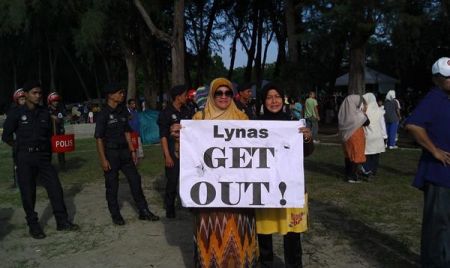The following is the text of a paper presented by Tommy Thomas at the Middle Temple Annual Conference 2013 at Kuala Lumpur, Malaysia from 19th to 20th September 2013 entitled “Judicial Review of Environmental and Planning Decisions – The Malaysian Perspective”.
Mr Chairman, My Lords, Ladies and Gentlemen :
I would like to thank Middle Temple for inviting me to present a paper at their Annual Conference, held for the very first time in Malaysia. As a lowly, overseas student coming down from a provincial red-brick university to the traditional week-end dinners at the hallowed halls of Middle Temple some 40 years ago, I could never have imagined that I would one day be addressing an esteemed audience of eminent English judges and barristers. I therefore regard this as a singular honour, and am humbled.
Common Law
English common law arrived in our shores at the end of the 18th century. Some 150 years later, on the eve of Malaya’s independence, Lord Reid was appointed Chairman of the Constitutional Commission to recommend a constitutional framework. Another key member was Professor Ivor Jennings of Cambridge, one of the leading constitutional scholars in the Commonwealth. When Malaya secured independence in 1957, the Reid Commission’s draft formed the basis of our Federal Constitution.
Independent Malaya decided to retain the Privy Council as its final appellate court and the common law system. Sadly, the Privy Council link was severed in 1986. The Bench and Bar cherish our membership of the universal brotherhood of the common law. A hallmark of common law is highly significant when discussing judicial review remedies, namely, that law-making is not restricted to the legislature, and judges make law.
Administrative Law
Judicial review provides the most effective remedies for the enforcement of rights of the individual against the state — the over-arching theme of this Conference. Judicial review being part of administrative law belongs to the realm of public law. English administrative law is substantially judge-made law; the quintessence of common law. Despite the rise of the welfare state and regime of licensing after the 2nd World War, English judges in the 1940’s and 1950’s did not advance the cause of judicial review, which led to this famous observation in 1964 by Lord Reid.
“We do not have a developed system of administrative law — perhaps because until fairly recently we did not need it.” Ridge v. Baldwin [1964] AC 40, 72 [HL]
But in just 20 years by a series of judicial decisions, English administrative law was transformed, which led Lord Diplock to remark:
It (Anisminic) is a legal landmark; it has made possible the rapid developments in England of a rational and comprehensive system of administrative law on the foundation of the concept of ultra vires…………The breakthrough (was) made by Anisminic …...”. Racal Communications [1980] 2 All ER 634, 638 – 639 [HL]
“….the progress towards a comprehensive system of administrative law ….I regard as having been the greatest achievement of the English courts in my judicial lifetime.” R v Inland Revenue Commissioners [1982] AC 617, 641 [HL]
The Malaysian judges of the 1970s and 1980s kept abreast of these developments. Led by Justices Eusoffe Abdoolcader and Harun Hashim, landmark cases like Ridge v. Baldwin, Conway v. Rimmer, Padfield, Anisminic and CCSU, were accepted as good law in Malaysia and applied consistently. Likewise, the established grounds of challenge, such as ultra vires, breach of natural justice, Wednesbury unreasonableness and Anisminic relevant and irrelevant considerations were consistently applied by our judges of that generation.
Judicial review in Malaysia enjoys constitutional status, adopting the Indian model. Article 4 of the Federal Constitution expressly provides for constitutional supremacy. Hence Dicey’s doctrine of parliamentary supremacy is not applicable here. Additionally, fundamental liberties are enshrined in Part II of the Federal Constitution. Articles 5 to 13 provide for the right to life, personal liberty, equality, anti-discrimination, freedom of movement, freedom of speech, assembly and association, freedom of religion, rights to education and to property. They are closely modeled on Part III of the Indian Constitution. Accordingly, decisions of the much respected Supreme Court of India are of great persuasive value to us.
Judicial review is anchored in statute. Paragraph 1 of the Schedule to the Courts of Judicature Act, 1964 reads:-
“Prerogative writs
Power to issue to any person or authority directions, orders or writs, including writs of the nature of habeas corpus, mandamus, prohibitions, quo warranto and certiorari, or any others, for the enforcement of the rights conferred by Part II of the Constitution, or any of them, or for any purpose.”
Procedurally, the matter is governed by Order 53 of the Rules of Court, 2012, which is based on Order 53 which came into force in the English Supreme Court Rules in 1977. For present purposes, the 2 stage process : ex-parte leave and inter-partes merits in Order 53 must be kept in mind.
PLANNING DECISIONS
The most significant planning case is probably Majlis Perbandaran Pulau Pinang v. Syarikat Bekerjasama Serbaguna Sungei Gelugor [1999] 3 MLJ 1 [FC], a Federal Court decision in 1999 pertaining to a planning permission granted by a city council to a landowner to construct a block of 10 storey flats on its land. Subsequently, the city council imposed new conditions, which were unacceptable to the landowner who sought to squash the decision by judicial review proceedings. The Federal Court granted an Order of Certiorari, and remitted the matter back to the council to reconsider the planning application according to the law. In reaching that conclusion, the Court held that the failure of the landowner to appeal to the Appeal Board constituted under the Town and Country Planning Act, 1976 was not a bar to seeking judicial review.
The majority of applicants challenging planning decisions are however not landowners who have grievances with local planning authorities with regard to development of their land. Rather, they are neighbours who are directly affected by the scale and magnitude of the proposed development. In such disputes, the neighbours have in recent years encountered great difficulty in even crossing the low threshold of securing leave, established by the leading case of Association of Bank Officers v. Malayan Commercial Banks Association [1990] 3 MLJ 228 [SC], usually on the ground that they have insufficient standing. Hence, locus standi is often the first defence of both the planning authority and the developer. The disputes seldom even reach the second stage under Order 53, and merits are not considered.
A recent illustration may be illuminating. In June 2010, the Petaling Jaya local council granted planning permission to a company to develop a massive project in the heart of Petaling Jaya to build 8 blocks of high rise buildings comprising :-
(i) 4 blocks of 22 to 37 — storey offices;
(ii) 2 blocks of 22-storey hotels; and
(iii) 2 blocks of 22-storey service apartments on top of a 6-story business podium/car park and a 4½ storey basement car park.
A coalition of residents associations challenged the planning permission by way of a judicial review application. In addition, to referring to the usual grounds of challenge, the residents also relied on fundamental liberties under the Federal Constitution, such as rights to a clean environment and enjoyment of their own property. Although the effect of the proposed development known as PJ Sentral would be to radically change the character of the entire area, and would unleash some 6 million square feet of built-up property in a suburb already filled with vacant and empty buildings, the judicial review application failed. The judge paid lip service to ultra vires and breach of justice, but did not apply them to the facts.

ENVIRONMENTAL DECISIONS
Legal challenges of major development projects grounded on a citizen’s right to a clean, pollution-free environment have sadly had miserable outcomes. 3 cases stand out.
First, the private law challenge by residents of Bukit Merah village to restrain a local company, the Asian Rare Earth Sdn Bhd belonging to a Japanese multi-national, from operating its rare earth factory because it discharged dangerous radioactive gases. The High Court granted an injunction to restrain the factory owner from discharging gases and from keeping toxin and radioactive waste on its land [See Wong Tan Ken v. Asian Rare Earth Sdn Bhd [1992] 3 CLJ (Rep.) 786]. On appeal, the Federal Court reversed the decision, but did not release any written grounds. In consequence, the rare earth operations resumed.
Secondly, the challenge by residents of long-houses in Sarawak of the proposed construction of the Bakun Dam in an area covering approximately 70,000 hectares of forest. The natives’ case was based on their dependence on the forest, from which they received from time immemorial, shelter, livelihood, food and medicine. There is also an ancestral and cultural attachment to land.
The High Court in Kajing Tubek v. Ekran Bhd [1996] MLJ 388 granted a declaration to the effect that until the developer had complied with the requirements imposed by Section 34A of the Environmental Quality Act of 1974, the project could not commence. The Court of Appeal in Ketua Pengarah Jabatan Alam Sekitar v. Kajing Tubek [1997] 3 MLJ 23 [CA] however allowed the appeal, and set aside the decision of the High Court. In consequence, the Bakun Dam was constructed.
Finally, the judicial review proceedings instituted last year by the residents in Kuantan against a Malaysian company belonging to an Australian multi-national, Lynas Corporation, intending to import rare earth ores from Western Australia to its plant in Gebeng near Kuantan where they would be processed for extraction of rare earth mineral. It is an undisputed fact that the operations at the plant would result in a generation of hazardous, radioactive wastes, which had to be disposed in Malaysia. The essence of the complaint of the residents was that the Lynas plant in their neighbourhood was merely a processing and dumping site for radioactive wastes which would not be permitted in their home country. The judicial review application received a dismal hearing before all the 3 courts in that they did not even clear the low threshold of securing leave. [The Court of Appeal decision is reported : Zakaria bin Abdullah v. Lembaga Perlesenan Tenaga Atom [2013] 5 MLJ 206 and the High Court decision is here.] Hence, their judicial review application was never determined by any court on its merits. In consequence, operations have begun at the Lynas plant.
The sequel to the decisions in the Asian Rare Earth and Bakun Dam is interesting. Public protests continued to be wide-spread against the rare earth factory in Bukit Merah, and after a few years, the Japanese multi-national for reputational purposes decided to cease operations in Bukit Merah. Unfortunately, thousands of tons of waste were left behind. The Bakun Dam caused massive ecological damage to the entire area. Thousands of natives were uprooted. Costs overrun resulted in its take-over by the government, which then transferred it to a GLC, Sime Darby. Cost overruns plagued the project under Sime Darby’s supervision. Litigation has spawned, and the dam, although completed, has still not started selling the electricity. It is too early to comment, even on the short-term consequences, of the Lynas rare earth plant.
These recent decisions indicate a trend whereby our courts do not consistently and regularly apply well established Malaysian common law principles in judicial review proceedings. In the eternal tension between the state and the individual, the balance leans overwhelmingly in favour of the state. Malaysia also does not have a developed system of administrative law — although we desperately need it.


This is a famous inspiring stipulation.I am fine numerous pleased along your excellent process.You put truly beneficial info. Reserve it up.
Very good paper presented by. Nice to read and i appreciate your writing skills and knowledge and waiting for new updates. Thank you very much for sharing your unique review with us.